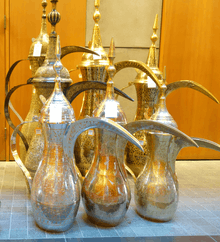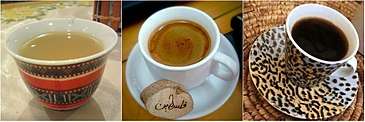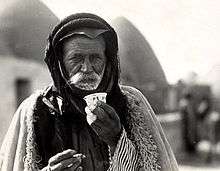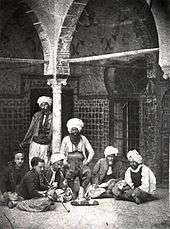Arabic coffee
Arabic coffee refers to a version of the brewed coffee of Coffea arabica beans. Arabic coffee is typically grown at a height of 1000 to 2000 meters, and represents about 60-70% of the coffee industry in the world.[1][2] Most Arab countries throughout the Middle East have developed unique methods for brewing and preparing coffee. Cardamom is an often-added spice,[3] but it can alternatively be served plain .
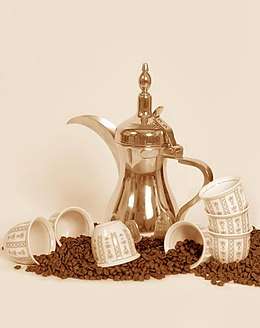 A dallah is a traditional Arabic coffee pot with cups and coffee beans | |
| Alternative names | Qahwah arabiyya |
|---|---|
| Type | Coffea arabica |
| Course | Drink |
| Place of origin | Yemen |
| Region or state | Arab World, Middle East |
| Associated national cuisine | Arab cuisine |
| Invented | 15th century |
| Serving temperature | Hot |
There are several different styles to brewing the coffee depending on the preference of the drinker. Some methods keep the coffee light, which usually contains cardamom, whereas others can make it dark. Arabic coffee is bitter, and typically no sugar is added. It is usually served in a small cup that is adorned with a decorative pattern, known as a finjān. Culturally, Arabic coffee is served during family gatherings or when receiving guests.
Arabic coffee is ingrained within Middle Eastern and Arab culture and tradition, and is the most popular form of coffee brewed in the Middle East. It originated in the Middle East, beginning in Yemen and eventually travelling to Mecca (Hejaz), Egypt, the Levant, and then, in the mid-16th century, to Turkey and from there to Europe where Coffee eventually became popular as well.[4] Arabic coffee is an Intangible Cultural Heritage of Arab states confirmed by UNESCO.[5]
Etymology

The word "coffee" entered the English language in 1582 via the Dutch koffie,[6] borrowed from the Ottoman Turkish kahve, in turn borrowed from the Arabic قَهْوَة (qahwa, “coffee, a brew”).[7] The word qahwah may have originally referred to the drink's reputation as an appetite suppressant from the word qahiya (Arabic: قَهِيَ, romanized: qahiya, lit. 'to lack hunger').[8][9] The name qahwah is not used for the berry or plant (the products of the region), which are known in Arabic as bunn. Semitic had a root qhh "dark color", which became a natural designation for the beverage. According to this analysis, the feminine form qahwah (also meaning "dark in color, dull(ing), dry, sour") also had the meaning of wine, which was also often dark in color.[10]
History
The earliest credible evidence of either coffee drinking or knowledge of the coffee tree appears in the middle of the 15th century, in Yemen's Sufi monasteries.[4] Sufis used it to keep themselves alert during their nighttime devotions. A translation of Al-Jaziri's manuscript[11] traces the spread of coffee from Arabia Felix (the present day Yemen) northward to Mecca and Medina, and then to the larger cities of Cairo, Damascus, Baghdad, and Constantinople. In 1511, it was forbidden for its stimulating effect by conservative, orthodox imams at a theological court in Mecca.[12] However, these bans were to be overturned in 1524 by an order of the Ottoman Turkish Sultan Suleiman I, with Grand Mufti Mehmet Ebussuud el-İmadi issuing a fatwa allowing the consumption of coffee.[13] In Cairo, Egypt, a similar ban was instituted in 1532, and the coffeehouses and warehouses containing coffee beans were sacked.[14]
Preparation
Arabic coffee is made from coffee beans roasted very lightly or heavily from 165 to 210 °C (329 to 410 °F) and cardamom, and is a traditional beverage in Arab culture.[15] Traditionally, it is roasted on the premises (at home or for special occasions), ground, brewed and served in front of guests. It is often served with dates, dried fruit, candied fruit or nuts.[16] Arabic coffee is defined by the method of preparation and flavors, rather than the type of roast beans. Arabic coffee is boiled coffee that is not filtered, made black. Sugar is not typically added, but if so, it can be added during preparation or when serving. It is served in a small delicate cup without handles, called finjān. Sometimes, the coffee is moved to a larger and more beautiful pour pitcher to serve in front of the guests, called Della. Often, though, the host prepares coffee in the kitchen and highlights a tray of small cups of coffee.[17] unlike Turkish coffee, traditional Arabic coffee, with its roots in Bedouin tradition, is usually unsweetened (qahwah saada), but sugar can be added depending on the preference of drinker. However, this coffee is never sweet syrup, but rather strong and bitter. To make up for the bitter flavor, coffee is usually served with something sweet – dates are a traditional accompaniment – and other desserts are often served along with a tray of coffee cups.[16]
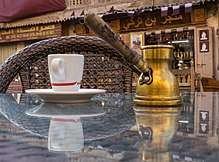
Arabian Peninsula
Arabs in the Persian Gulf are also creative in the way they prepare coffee. Coffee is different from that in Egypt and Levant in terms of bitterness and the type of cups the coffee is served in. This brewing method is common in Najd and Hejaz, and sometimes other spices like saffron (to give it a golden color), cardamom, cloves, and cinnamon. Arabic coffee in Najd and Hejaz takes a golden color, while in North Arabia a type of Arabic coffee known as qahwah shamālia[18][19] (literally means Northern Coffee) it looks darker in color, because roasting the coffee beans takes a bit longer. Northern coffee is also known as Bedouin coffee in Jordan. Some people add a little-evaporated milk to slightly alter its color; however, this is rare. It is prepared in and served from a special coffee pot called dallah (Arabic: دلة); more commonly used is the coffee pot called cezve (also called rikwah or kanaka) and the coffee cups are small with no handle called fenjan. The portions are small, covering just the bottom of the cup. It is served in homes, and in good restaurants by specially clad waiters called gahwaji, and it is almost always accompanied with dates. It is always offered with the compliments of the house.
Levant
The hot beverage that Palestinians consume is coffee – served in the morning and throughout the day. The coffee of choice is usually Arabic coffee. Arabic coffee is similar to Turkish coffee, but the former is spiced with cardamom and is usually unsweetened.[20] Among Bedouins and most other Arabs throughout the region of Palestine, bitter coffee, known as qahwah sadah (Lit. plain coffee), was a symbol of hospitality. Pouring the drink was ceremonial; it would involve the host or his eldest son moving clockwise among guests – who were judged by age and status – pouring coffee into tiny cups from a brass pot. It was considered "polite" for guests to accept only three cups of coffee and then end their last cup by saying daymen, meaning "always", but intending to mean "may you always have the means to serve coffee".[21]
In Lebanon, the coffee is prepared in a long-handled coffee pot called "rakwe". Coffee is poured directly from "rakwe" to a small cup that is adorned with a decorative pattern, known as a finjān.[22] The finjān has a capacity of 60-90 ml (2-3 oz fl). Lebanese coffee is traditionally strong and black and is similar to the coffee of other Middle Eastern countries. However it differs in its beans and roast, where the blonde and dark beans are mixed together. It is also ground into a very particle like size.[23] It is often joked that a Lebanese person who does not drink coffee is in danger of losing their nationality.[22]
Drinks in Syria vary depending on the time of day and the occasion. Arabic coffee is the most well-known hot drink usually prepared in the morning at breakfast or in the evening. It is usually served for guests or after food.
Arabic coffee is much more than just a drink in Jordan – it is a traditional sign of respect and a way to bring people together. Black, cardamom-flavored Arabic coffee, also known as qahwah sādah (welcome coffee), deeply ingrained in Jordanian culture. Providing coffee (and tea) to guests is a large part of the intimate hospitality of the Hashemite Kingdom.
Morocco
While the national drink of Morocco is gunpowder green tea brewed with fresh mint and espresso is very popular, Arabic coffee is also widely consumed, especially on formal occasions. It is often made with the purpose of conducting a business deal and welcoming someone into one's home for the first time, and frequently served at weddings and on important occasions.
Cultivation
Much of the popularization of coffee is due to its cultivation in the Arab world, beginning in what is now Yemen, by Sufi monks in the 15th century.[24] Through thousands of Arabs pilgrimaging to Mecca, the enjoyment and harvesting of coffee, or the "wine of Araby" spread to other Arab countries (e.g. Egypt, Syria) and eventually to a majority of the world through the 16th century. Coffee, in addition to being essential in the home, became a major part of social life.[25] Coffeehouses, qahwa قَهوة in Modern Standard Arabic, became "Schools of the Wise" as they developed into places of intellectual discussion, in addition to centers of relaxation and comradery.[26]
Coffeehouse
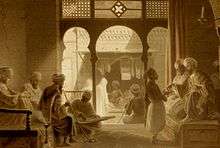
Coffeehouse culture began in the Arab world, and eventually spread to other areas of the world and blended with the local culture.[27] Traditional Arab coffeehouses are places where mostly men meet to socialize over games, coffee, and water pipes (shisha or argille). Depending on where the coffeehouse is, its specialty differs. In Maghreb, green tea is served with mint or coffee is served Arab and/or European style. Arabic coffee, or Turkish coffee, is made in Egypt and the Levant countries. Arabic coffee is a very small amount of dark coffee boiled in a pot and presented in a demitasse cup. Particularly in Egypt, coffee is served mazbuuta, which means the amount of sugar will be "just right", about one teaspoon per cup. However, in the Arabian Peninsula, Arabic coffee is roasted in such a way that the coffee is almost clear. In all of the Arab world, it is traditional for the host to refill the guest's cup until politely signaled that the guest is finished.[25]
Served
Arabic coffee is usually served just a few centiliters at a time. The waiter/host serves the guest just enough to cover the bottom of the cup. Usually, the coffee is boiling hot, so larger amounts would take too long to cool to a drinkable temperature.[15] The guest drinks it and if he wishes, he will gesture to the waiter not to pour any more. Otherwise, the host/waiter will continue to serve another few centilitres at a time until the guest indicates he has had enough. The most common practice is to drink only one cup since serving coffee serves as a ceremonial act of kindness and hospitality. Sometimes people also drink larger volumes during conversations.[28]
Customs
The cups are normally only filled partway, and the custom is to drink three cups.[29] Arabic coffee has a prominent place in traditional Arab holidays and special events such as Ramadan and Eid.
Fortune-telling
Arabic coffee reading (Arabic: قراءة الفنجان, romanized: qirāʾat al-finjān), is similar to tea-leaf reading; the client is asked to consume strong fresh Arabic coffee leaving approximately a teaspoon of liquid in the cup. The cup is then inverted onto a saucer to allowing the residual liquid to drain away. The reader will then interpret the patterns formed by the thick residue on the inside of the cup.[30]
Funeral
Arabic funerals gather families and extended relatives, who drink bitter and unsweetened coffee and restore the life and characteristics of the deceased. The men and women gather separately, and it has become very fashionable to employ very presentable women whose only job is to serve coffee all day to the women. Male waiters serve the men. Arab Muslims and Christians share this tradition.[31]
Nutrition facts
A small cup of Arabic coffee has almost no calories or fat. It contains a small amount of protein.[32][33]
See also
- Arabic tea
- Arab cuisine
- Home roasting coffee
- Green coffee
- Turkish coffee
References
- "Botanical Aspects". London: International Coffee Organization. Archived from the original on 24 March 2009. Retrieved 4 January 2010.
- "1.2.5-World coffee trade-World production by type: arabica and robusta". www.intracen.org.
- "Ingredients Arabic Coffee". Archived from the original on 2018-12-28. Retrieved 2017-10-06.
- Weinberg, Bennett Alan; Bealer, Bonnie K. (2001). The world of caffeine. Routledge. pp. 3–4. ISBN 978-0-415-92723-9.
coffee goat ethiopia Kaldi.
- "Arabic coffee, a symbol of generosity - intangible heritage - Culture Sector - UNESCO". www.unesco.org. Retrieved 2017-04-04.
- OED, s.v. "Coffee".
- Oxford English Dictionary, 1st ed. "coffee, n." Oxford University Press (Oxford), 1891.
- Kaye, Alan (1986). "The Etymology of Coffee: The Dark Brew". Journal of the American Oriental Society. 106 (3): 557–558. doi:10.2307/602112. JSTOR 602112.
- قهي. الباحث العربي (in Arabic). Retrieved September 25, 2011.(see also qahiya: Hans Wehr's Dictionary of Modern Written Arabic. page 930.)
- Kaye, Alan S. (1986). "The etymology of "coffee": The dark brew". Journal of the American Oriental Society. 106 (3): 557–558. doi:10.2307/602112. JSTOR 602112.
- Al-Jaziri's manuscript work is of considerable interest with regards to the history of coffee in Europe as well. A copy reached the French royal library, where it was translated in part by Antoine Galland as De l'origine et du progrès du café.
- "resource for Arabic books". www.alwaraq.net.
- Schneider, Irene (2001). "Ebussuud". In Michael Stolleis (ed.). Juristen: ein biographisches Lexikon; von der Antike bis zum 20. Jahrhundert (in German) (2nd ed.). München: Beck. p. 193. ISBN 3-406-45957-9.
- J. E. Hanauer (1907). "About Coffee". Folk-lore of the Holy Land. pp. 291 f.
[All] the coffee-houses [were] closed, and their keepers pelted with the sherds of their pots and cups. This was in 1524, but by an order of Selìm I., the decrees of the learned were reversed, the disturbances in Egypt quieted, the drinking of coffee declared perfectly orthodox
- "What makes Arabic coffee unique?". Your Middle East (in Swedish). Retrieved 2017-04-14.
- "Gulf Arabic coffee - qahwa arabiyyah". www.dlc.fi. Retrieved 2017-04-14.
- "How To Make Arabic Coffee". Terrace Restaurant & Lounge. 2015-03-01. Retrieved 2017-04-14.
- Al Asfour, Saud. "القهوة الكويتية.. أصالة وعراقة". Alqabas.
- Al Asfour, Saud. "القهوجي.. "صَبَّاب القهوة" في الكويت قديماً". Alqabas.
- The rich flavors of Palestine Archived 2009-04-16 at the Wayback Machine Farsakh, Mai M. Institute for Middle East Understanding (IMEU), (Originally published by This Week in Palestine) 2006-06-21 Accessed on 2007-12-18
- A Taste of Palestine: Menus and Memories (1993). Aziz Shihab. Corona Publishing Co. p.5 ISBN 978-0-931722-93-6
- "Food Heritage Foundation – Lebanese coffee". food-heritage.org. Retrieved 2018-08-20.
- "Lebanese Coffee, Coffee passion". maatouk.com. Retrieved 2018-08-20.
- Civitello, Linda (2007). Cuisine and Culture: A History of Food and People. Hoboken, NJ: John Wiley. ISBN 9780471741725.
- Brustad, Kristen; Al-Batal, Mahmoud; Al-Tonsi, Abbas (2010). Alif Baa: Introduction to Arabic Letters and Sounds. Georgetown University Press. p. 132. ISBN 9781589016330.
- "The History Of Coffee". ncausa.org. National Coffee Association of the U.S.A. October 24, 2016.
- S., Hattox, Ralph (2014-01-01). Coffee and Coffeehouses The Origins of a Social Beverage in the Medieval Near East. University of Washington Press. ISBN 978-0295805498. OCLC 934667227.
- "Arabic Coffee Service | GWNunn.com". gwnunn.com. Retrieved 2017-04-14.
- "Arabic Coffee - A Welcoming Ritual". Cabin Crew Excellence. Archived from the original on 2015-08-17. Retrieved 2017-04-14.
- "Jane - Fortune Teller | Middlesex| South East| UK - Contraband Events". Contraband Events.
- IMEU. "Palestinian Social Customs and Traditions | IMEU". imeu.org. Retrieved 2017-04-14.
- Cherney, Kristeen. "Arabic Coffee Nutrition Information". LIVESTRONG.COM. Retrieved 2017-04-14.
- Tulsani, Manoj (2013-05-29). "5 Interesting Facts About Arabic Coffee". Travel Tips and Experience - Rayna Tours and Travels. Retrieved 2017-04-14.
Further reading
- Basan, Ghillie (2007). Middle Eastern Kitchen. Hippocrene Books. p. 37. ISBN 978-0781811903.
- Young, Daniel (2009). Coffee Love: 50 Ways to Drink Your Java. John Wiley & Sons. p. 44. ISBN 978-0470289372.
